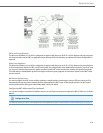
Network Settings
4-28 41-001343-02 REV04 – 05.2014
If you enable NAT, the phone uses the NAT port number (and NAT IP address) in the Via and Contact SIP headers of SIP
messages, but still use the configured source port.
Configuring SIP and TLS Source Ports Using the Configuration Files
You use the following parameters to configure SIP and TLS ports for NAT traversal:
• sip local port
• sip local tls port
Note:
• By default, the IP phones use symmetric UDP signaling for outgoing UDP SIP messages. When symmetric UDP is ena-
bled, the IP phone generates and listens for UDP messages using port 5060.If symmetric UDP signaling is disabled,
the phone sends from random ports but it listens on the configured SIP local port. Refer to Symmetric UDP Signaling
on page 6-25 for more information.
• The IP phones also use symmetric TLS signaling for outgoing TLS SIP messages by default. When symmetric TLS is
enabled, the IP phone uses port 5061 as the persistent TLS connection source port. When symmetric TLS signaling is
disabled, the IP phone chooses a random persistent TLS connection source port for TLS messages from the TCP range
(i.e. 49152...65535) after each reboot regardless of whether the parameter “sip outbound support” is enabled or dis-
abled. Refer to Symmetric TLS Signaling on page 6-25 for more information.
Configuration Files
For specific parameters you can set in the configuration files, see Appendix A, the sections:
• “Local SIP UDP/TCP Port Setting” on pageA-26.
• “Local SIP TLS Port” on pageA-27.


















